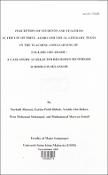Options
Perception Of Students And 'Teachers In The Use Of Print, Audio And Visual Literary Texts In The Teaching And Learning Of English And Arabic: A Case-Study At Selected Religious Secondary Schools In Selangor
Date Issued
2009
Author(s)
Massari, Norhaili
Behak, Fariza Puteh
Mohamad, Wan Moharani
Ismail, Muhammad Manvan
Abstract
Many researchers have revealed the advantages of using literary texts in the language classroom, predominantly as it contributes to language, cultural and personal growth. USIM students reported that when they were leaming English and Arabic in their secondary schools, they were more focused on the textbooks and hardly any literary texts were in use in the teaching and leaming of both languages. This study intended to investigate whether literary texts were used in the teaching and leaming (T&L) of English (ELC) and Arabic (ALC). Specifically, this study aimed to investigate the different types of print, audio and visual literary texts that have been used in the ELC and ALC as perceived by the teachers and students. It also intended to find out the perceptions of teachers and students regarding the use of literary texts in the T&L of ELC and ALC. This study focused on the perceptions of 167 Form Four students and the 16 English and Arabic language teachers teaching them, in the use of audio, print and visual literary texts in the teaching and learning (T&L) of English (ELC) and Arabic( ALC) at two religious secondary schools via questionnaires. The findings revealed that literary texts were used and perceived positively by teachers and students of ELC and ALC in general. This may provide a groundwork for further research investigations, for example; the use of literary texts with students' motivation or development of specific language skills such as vocabulary or critical thinking skills. The findings also show that the use of audio visual texts, particularly the use of non canonical texts or contemporary literary texts such as songs, video clips, comics and films are more popular in the T&L of ELC and ALC as compared to the print texts. Thus, researchers and practitioners could explore further on this phenomenon and how some of these materials can be incorporated more effectively in the English and Arabic language classroom. This study was unique as it provided the perceptions of students and teachers from the Malaysian experience, particularly of religious secondary schools in Selangor (as among future candidates to USIM), specifically in the use of print, audio and visual literary texts in the teaching and leaming of English and Arabic.
File(s)
Loading...
Name
Perception Of Students And 'Teachers In The Use Of Print, Audio And Visual Literary Texts In The Teaching And Learning Of English And Arabic; A Case-Study At Selected Religious Secondary Schools In Selangor.pdf
Size
6.61 MB
Format
Adobe PDF
Checksum
(MD5):fde985367c95e3e2c4afc1beff00868b